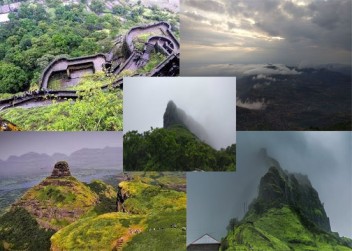1) Trek To Harishchandragad :
- Location: Ahmednagar district
- Highlights: Harishchandragad is known for its challenging trek, ancient temples, and the Konkan Kada, a stunning cliff with panoramic views. The trek involves diverse terrains, including forests,
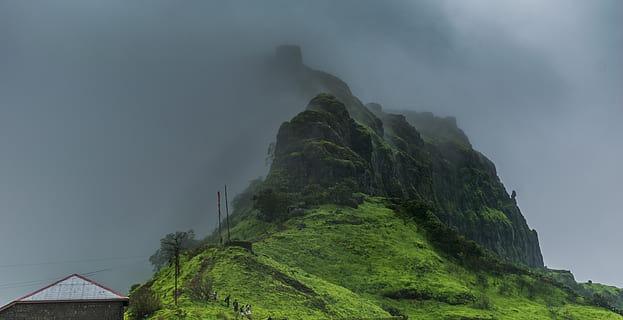
The fort’s history dates back to the 12th century when it was initially built by the Yadava dynasty as Devagiri Fort. It served as the capital of the Yadava Kingdom. The original name Devagiri means “Hill of the Gods.”
Conquest by Alauddin Khilji (1296) :
In 1296, Alauddin Khilji, the ruler of the Delhi Sultanate, captured Devagiri Fort after a prolonged siege. The fort’s strategic location made it a significant stronghold in the region.
Renaming as Daulatabad:
After the conquest, Alauddin Khilji renamed the fort as Daulatabad, meaning the “Abode of Wealth.” The name change reflected the fort’s newfound importance as a key military and administrative center.
Shift of Capital:
Muhammad bin Tughlaq, the Sultan of Delhi, decided to shift the capital from Delhi to Daulatabad in 1327. However, the decision faced numerous challenges, including logistical issues and public resistance. Eventually, the capital was shifted back to Delhi, but the move had a significant impact on the region.
Vijayanagara Rule:
In the 14th century, the Vijayanagara Empire gained control of Daulatabad. The fort continued to play a crucial role in the Deccan region’s history.
Later History:
Over the centuries, the fort changed hands multiple times, with various dynasties and rulers asserting control. It was later captured by the Bahmani Sultanate and subsequently by the Mughal Empire under Emperor Aurangzeb.
Architectural Features:
The fort is known for its strong defense mechanisms, including multiple walls and gates, as well as a complex series of secret passages. The Chand Minar, a tall tower within the fort, was added by the Bahmani rulers.
Harishchandragad is situated in the Malshej Ghat region of the Western Ghats, at an elevation of approximately 4,671 feet (1,423 meters) above sea level.
Highlights of the Trek:
1. Diverse Terrain: The trek to Harishchandragad offers a mix of terrains, including dense forests, rocky patches, and steep ascents. Trekkers encounter a variety of landscapes throughout the journey.
2. Konkan Kada: One of the main attractions of Harishchandragad is the Konkan Kada, a massive cliff that provides panoramic views of the Konkan region. The sunrise and sunset views from Konkan Kada are especially spectacular.
3. Kokankada Camping: Many trekkers choose to camp near Konkan Kada to experience the tranquility of the surroundings and witness the night sky filled with stars.
4. Ancient Temples: The fort has several ancient temples, including the Kedareshwar Cave Temple, which houses a Shiva Linga surrounded by water. The Nageshwar Temple and Harishchandreshwar Temple are other notable religious structures on the fort.
5. Taramati Peak: Trekkers often visit Taramati Peak, the highest point on Harishchandragad, for stunning panoramic views of the Sahyadri range.
History of Harishchandragad:
Ancient Roots:
· Harishchandragad has a history dating back to ancient times. It is mentioned in various ancient scriptures, including the Matsyapuran, Skandapuran, and Agnipuran.
Chhatrapati Shivaji Maharaj’s Era:
· During the rule of Chhatrapati Shivaji Maharaj, the fort played a strategic role. It was one of the forts that Shivaji Maharaj captured from the Mughals.
Maratha Rule:
· In subsequent years, the fort exchanged hands between the Marathas and the Mughals. It was an essential part of the Maratha defense network.
Architectural Features:
· The fort exhibits various architectural features, including fortification walls, bastions, and the remnants of ancient structures.
Harishchandragad stands as a testament to the rich historical and cultural heritage of Maharashtra. The trek not only offers adventure and scenic beauty but also allows trekkers to connect with the historical significance of the region. Visiting Harishchandragad is an immersive experience that combines nature, history, and spirituality.
2) Trek to Kalsubai Peak:
- Location: Ahmednagar district
- Highlights: Kalsubai is the highest peak in Maharashtra. The trek takes you through lush greenery, open meadows, and challenging rocky patches. The summit offers breathtaking views of the surrounding Sahyadri range.
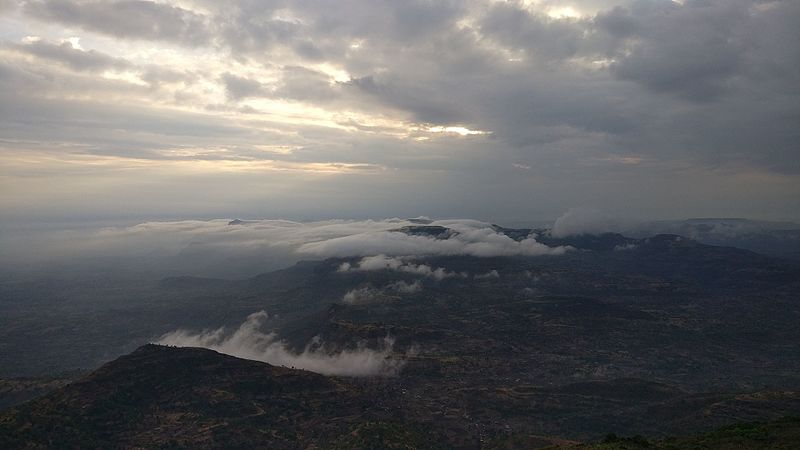
Kalsubai, proudly standing as the highest peak in the Western Ghats of Maharashtra, is a majestic elevation that beckons adventure seekers and nature enthusiasts alike. At an impressive altitude of 5,416 feet (1,652 meters) above sea level, the trek to Kalsubai Peak is a thrilling escapade, showcasing diverse terrains, cultural landmarks, and breathtaking vistas. Let’s delve into the details of this enthralling journey and the rich history that envelopes Kalsubai.
Trek to Kalsubai Peak:
Location: Nestled in the Sahyadri mountain range within the Ahmednagar district of Maharashtra, India, Kalsubai provides a haven for those seeking an exhilarating trekking experience.
Highlights of the Trek:
Diverse Terrain: Embarking on the Kalsubai trek unveils a tapestry of landscapes, ranging from dense forests to rocky patches, culminating in a challenging ascent through a steep and rugged trail.
Hanuman Temple: En route to the summit, trekkers encounter the Kalsubai Temple, a sacred homage to the local deity, Kalsubai. Additionally, a small shrine dedicated to Lord Hanuman graces the path to the peak.
Scenic Beauty: The trek rewards adventurers with panoramic views of the Sahyadri mountains, verdant valleys, and the sprawling Bhandardara Dam. The summit, especially during sunrise, offers a spectacle that etches itself into the memory.
Monsoon Attraction: The allure of Kalsubai is heightened during the monsoon season when the landscape transforms into a lush green canvas, adorned with cascading waterfalls, creating a mesmerizing setting for trekkers.
Challenging Ascent: While accessible to beginners, the final climb to the peak demands stamina and determination. The challenge adds to the sense of accomplishment upon reaching the summit.
History of Kalsubai:
Temple and Local Legend: The Kalsubai Temple at the base pays homage to the local deity, Kalsubai, whose legend narrates a tale of resilience and escape from adversity. The temple stands as a testament to her bravery and determination.
Maratha Era: With historical roots dating back to the Maratha era, Kalsubai served as a strategic watchtower, offering a vantage point to surveil the surrounding regions.
Weather Station: During the British colonial period, Kalsubai served a practical purpose as a weather station, monitoring weather conditions in the region.
Accessibility and Conservation: Recent efforts have been made to enhance the trekking route, promoting sustainable tourism. Conservation initiatives aim to preserve the natural beauty of this region for generations to come.
In conclusion, Kalsubai Peak, with its blend of trekking challenges and historical significance, stands as a magnet for nature lovers, adventure enthusiasts, and pilgrims. The journey to the summit is not just a physical feat but a holistic experience, offering a profound connection with nature and a view from the highest point in Maharashtra that is truly awe-inspiring.
3) Trek to Ratangad:
- Location: Ahmednagar district
- Highlights: Ratangad is known for its ancient fort, scenic surroundings, and the famous “Nedhe” or the eye of the needle. The trek provides a mix of history and natural beauty, with panoramic views of the Bhandardara region.
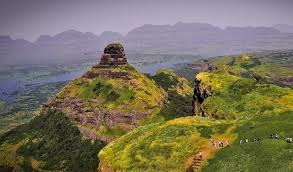
Ratangad is a historic hill fort located in the Western Ghats of Maharashtra, India. It is situated near the Bhandardara region and is a popular trekking destination, known for its scenic beauty, ancient temples, and historical significance. Here’s a more detailed overview of the Ratangad trek and a brief history:
Trek to Ratangad:
Location:
Ratangad is situated in the Sahyadri mountain range in the Ahmednagar district of Maharashtra.
Highlights of the Trek:
- Lush Greenery and Waterfalls: The trek to Ratangad takes you through lush green landscapes, dense forests, and alongside picturesque waterfalls, especially during the monsoon season.
- Ancient Fortifications: The fort is known for its ancient fortifications, bastions, and remnants of structures that reflect its historical importance. The architecture is a mix of Maratha and Bahmani styles.
- Ratangad Fort Entrance (Nedhe): The entrance to the fort is marked by a unique rock-cut staircase called the “Nedhe” or “the eye of the needle.” It’s a challenging feature that adds excitement to the trek.
- Amruteshwar Temple: At the summit, there is an ancient temple known as the Amruteshwar Temple, dedicated to Lord Shiva. The temple showcases intricate carvings and adds a religious aspect to the trek.
- Breathtaking Views: The summit offers panoramic views of the surrounding Sahyadri mountains, the Bhandardara Dam, and the Arthur Lake.
History of Ratangad:
Ancient Roots:
- Ratangad has a rich history that dates back to the Yadava dynasty in the 12th century. It was initially built for defense purposes during this period.
Maratha Rule:
- During the Maratha era, Ratangad played a strategic role in the region’s defense. Chhatrapati Shivaji Maharaj captured and secured the fort as part of the Maratha fortification network.
Architectural Features:
- The fort exhibits various architectural features, including fortification walls, gates, water cisterns, and the Amruteshwar Temple. The construction style reflects the engineering skills of the time.
Nedhe or “The Eye of the Needle”:
- The Nedhe, a unique rock-cut staircase, serves as the main entrance to the fort. It is a challenging and distinctive feature that showcases the ingenuity of the fort’s builders.
Conservation and Trekking:
- In recent years, efforts have been made to promote sustainable tourism and conserve the fort’s historical and natural heritage. The trek attracts adventure enthusiasts and history aficionados alike.
Ratangad’s trek not only offers a physical challenge but also allows trekkers to connect with the historical and cultural significance of the region. The fort’s ancient structures, coupled with the stunning views, make it a popular destination for those seeking a blend of adventure and history.
4) Trek to Lohagad Fort:
Lohagad Fort:
- Location: Pune district
- Highlights: Lohagad Fort is easily accessible and offers a relatively easy trek. The fort has historical significance, and the trek provides beautiful views of the surrounding hills and the Pawna Lake.
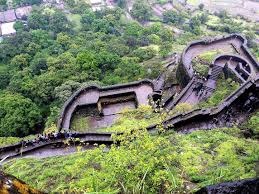
Lohagad Fort, nestled near Pune in the Sahyadri mountain range of Maharashtra, India, is a captivating historical hill fort that beckons trekkers with its intriguing past and breathtaking views. Let’s delve into the details of the Lohagad Fort trek and explore the historical tapestry that adorns its rugged landscapes.
Trek to Lohagad Fort:
Location: Situated in the vicinity of the hill station of Lonavala in the Pune district, Lohagad Fort offers a convenient trekking destination for enthusiasts in Maharashtra.
Highlights of the Trek:
Ease of Accessibility: Renowned for its ease of accessibility, the trek to Lohagad Fort is considered relatively easy, catering to both beginners and families seeking a memorable outdoor experience.
Scenic Beauty: The trek unveils a picturesque landscape adorned with lush greenery, reaching its zenith during the monsoon season when vibrant vegetation blankets the surroundings, creating a mesmerizing ambiance.
Climb to the Fort: Ascending a series of steps leading to the fort, trekkers are rewarded with panoramic views of the Sahyadri mountains and the enchanting landscapes that sprawl beneath.
Bhairavnath Temple: At the summit, a small temple dedicated to Bhairavnath, a form of Lord Shiva, adds a spiritual dimension to the trek, providing trekkers with a moment of introspection and reverence.
Visapur Fort View: Lohagad Fort’s proximity to Visapur Fort allows trekkers to relish expansive views of the neighboring Visapur Fort and the glistening waters of the Pawna Dam.
History of Lohagad Fort:
Ancient Roots: Dating back to the 2nd century, Lohagad Fort was constructed by the Satavahana dynasty. It subsequently witnessed the passage of various dynasties, including the Chalukyas and Rashtrakutas.
Maratha Rule: In 1648, during the Maratha era, Chhatrapati Shivaji Maharaj captured Lohagad Fort, bestowing it with strategic importance in the defense strategy of the Maratha Empire.
Architectural Features: Boasting impressive architectural features, the fort showcases well-preserved fortification walls, gates, and a notable stepwell known as the “Gaymukh.”
Capture by Mughals: During the tumultuous historical period of 1689, Lohagad Fort fell temporarily into the hands of the Mughals but was later recaptured by the resilient Marathas.
Conservation and Tourism: Recent endeavors have been dedicated to conserving the fort’s historical significance while promoting tourism. The trek attracts a diverse array of visitors, including history enthusiasts and nature lovers, contributing to the region’s cultural and natural heritage.
In essence, Lohagad Fort stands as a testament to the region’s rich history, embodying the strategic importance of hill forts throughout various historical epochs. The trek to Lohagad Fort, with its blend of historical marvels and scenic splendor, offers adventurers a perfect synergy of cultural exploration and outdoor adventure, creating lasting memories and fostering an appreciation for the heritage of Maharashtra.
5) Trek to Rajmachi:
Rajmachi:
- Location: Pune district
- Highlights: Rajmachi comprises two forts, Shrivardhan and Manaranjan, and is accessible through a scenic trek. The route takes you through dense forests, waterfalls, and open meadows. The view of the Kataldhar and Bhivpuri waterfalls is mesmerizing.
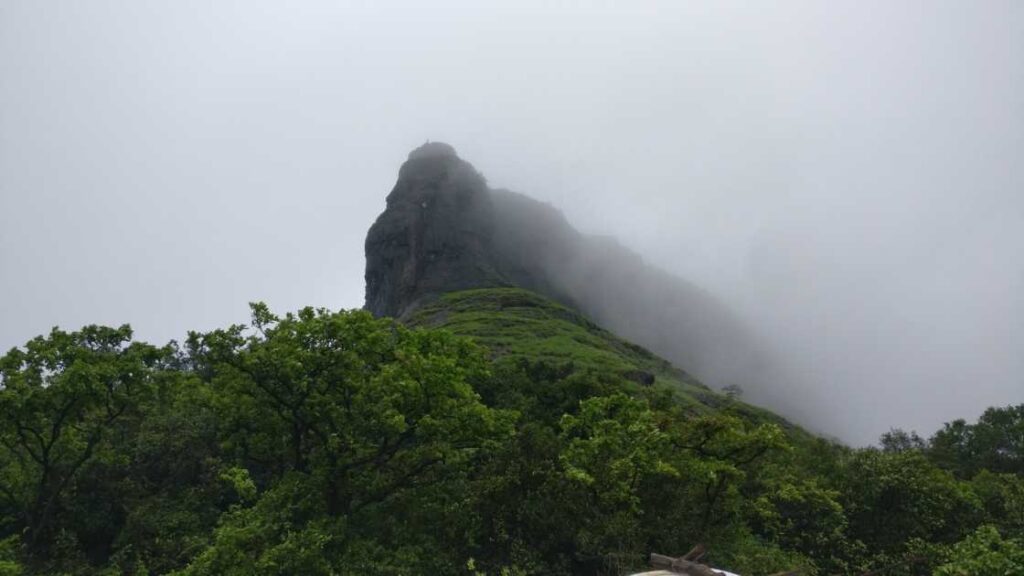
Rajmachi is situated in the Sahyadri mountain range, near the hill stations of Lonavala and Khandala in the Pune district of Maharashtra.
Highlights of the Trek:
- Two Forts: Rajmachi consists of two forts – Shrivardhan Fort and Manaranjan Fort – located on two adjacent peaks. Both forts offer panoramic views of the surrounding hills.
- Lush Greenery: The trek to Rajmachi takes you through lush green landscapes, dense forests, and open meadows, providing a serene and picturesque journey.
- Udhewadi Village: The base village for the trek is Udhewadi, which is home to a few local families. The trek involves ascending and descending through various trails.
- Historical Structures: The forts have well-preserved historical structures, including fortification walls, gates, and ancient water cisterns. These structures reflect the architectural and military brilliance of the Maratha era.
- Breathtaking Sunset and Sunrise: Rajmachi is known for its spectacular sunset and sunrise views. Many trekkers prefer camping overnight to witness the mesmerizing play of colors in the sky.
History of Rajmachi Fort:
Ancient Roots:
- Rajmachi has a history dating back to the Satavahana dynasty. It served as a strategic military post and watchtower to guard the trade route between Khopoli and Khandala.
Maratha Rule:
- During the Maratha era, Chhatrapati Shivaji Maharaj captured Rajmachi in 1657. The forts played a crucial role in the Maratha Empire’s defense strategy and served as a base for military operations.
Military Importance:
- Rajmachi was considered strategically important due to its location at the confluence of the Bor Ghat and the Konkan region. It provided a vantage point to monitor and control the trade routes.
Capture by the British:
- The British East India Company captured Rajmachi in 1818 after the conclusion of the Third Anglo-Maratha War. The forts lost their military significance during the British rule.
Conservation and Tourism:
- In recent years, there have been efforts to promote sustainable tourism and conserve the historical structures of Rajmachi. The trek attracts adventure enthusiasts, history lovers, and nature photographers.
Rajmachi Fort, with its twin forts, historical structures, and scenic landscapes, offers trekkers a unique blend of adventure and historical exploration. The forts stand as silent witnesses to the region’s rich history and the valor of the Maratha warriors who once ruled these lands.


